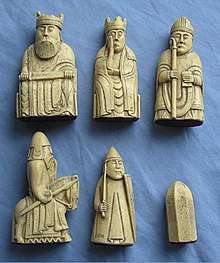Chess piece

A chess piece, or chessman, is any of the six different movable objects used on a chessboard to play the game of chess.
Number of pieces
  |
King |
|---|---|
  |
Queen |
  |
Rook |
  |
Bishop |
  |
Knight |
  |
Pawn |
Each player begins with a total of sixteen pieces. The pieces that belong to each player are distinguished by color. The lighter colored pieces are referred to as "white," and the player that owns them, "White". The darker colored pieces are referred to as "black", and the player that owns them, "Black". The word "piece" has three meanings, depending on the context. The context should make the intended meaning clear (Burgess 2009:523) (Hooper & Whyld 1992:307).
- It may mean any of the physical pieces of the set, including the pawns. When used this way, "piece" is synonymous with "chessman" (Hooper & Whyld 1992:307) or simply "man" (Hooper & Whyld 1987:200).
- In play, the term is usually used to exclude pawns, referring only to a queen, rook, bishop, knight, or king. In this context, the pieces can be broken down into three groups: major pieces (queen and rook), minor pieces (bishop and knight), and the king (Brace 1977:220).
- In phrases such as "winning a piece", "losing a piece" or "sacrificing a piece", it refers only to a bishop or knight. The queen, rook, and pawn are specified by name in these cases, for example, "winning a queen", "losing a rook", or "sacrificing a pawn" (Just & Burg 2003:5).
In the first context, each of the two players begins with the following sixteen pieces in a standard game:
Moves of the pieces
| a | b | c | d | e | f | g | h | ||
| 8 |  | 8 | |||||||
| 7 | 7 | ||||||||
| 6 | 6 | ||||||||
| 5 | 5 | ||||||||
| 4 | 4 | ||||||||
| 3 | 3 | ||||||||
| 2 | 2 | ||||||||
| 1 | 1 | ||||||||
| a | b | c | d | e | f | g | h | ||
The rules of chess prescribe the types of move a player can make with each type of chess piece. Each piece type moves in a different way. During play, the players take turns moving one of their own chess pieces.
- The rook moves any number of vacant squares forwards, backwards, left, or right in a straight line. It also takes part, along with the king, in a special move called castling.
- The bishop moves any number of vacant squares diagonally in a straight line. Consequently, a bishop stays on squares of the same color throughout a game. The two bishops each player starts with move on squares of opposite colors.
- The queen moves any number of vacant squares in any direction: forwards, backwards, left, right, or diagonally, in a straight line.
- The king moves exactly one vacant square in any direction: forwards, backwards, left, right, or diagonally; however, it cannot move to a square that is under attack by an opponent, nor can a player make a move with another piece if it will leave the king in check. It can also castle in conjunction with a rook.
- The knight moves on an extended diagonal from one corner of any 2×3 rectangle of squares to the furthest opposite corner. Consequently, the knight alternates its square color each time it moves. The knight is the only piece that jumps over any intervening piece(s) when moving (castling being the only special instance in which pieces jump over one another).
- The pawn moves forward exactly one space, or optionally, two spaces when on its starting square, toward the opponent's side of the board. When there is an enemy piece one square diagonally ahead of the pawn, either left or right, then the pawn may capture that piece. A pawn can perform a special type of capture of an enemy pawn called en passant. If the pawn reaches a square on the back rank of the opponent, it promotes to the player's choice of a queen, rook, bishop, or knight (Just & Burg 2003:13–16).
Pieces other than pawns capture in the same way that they move. A capturing piece replaces the opponent piece on its square, except for an en passant capture. Captured pieces are immediately removed from the game. A square may hold only one piece at any given time. Except for castling and the knight's move, no piece may jump over another piece (Just & Burg 2003:13–16).
Chess sets
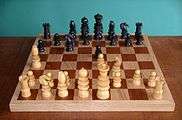 A St. George style set
A St. George style set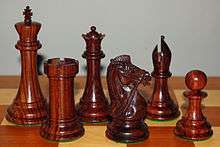 Staunton pieces made of rosewood
Staunton pieces made of rosewood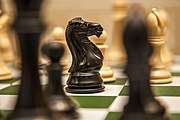 Staunton pieces made of plastic
Staunton pieces made of plastic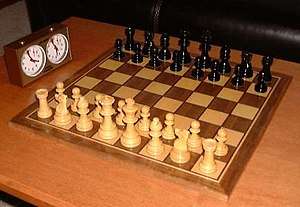 Staunton chess pieces on chess board with chess clock
Staunton chess pieces on chess board with chess clock
Table sets
The variety of designs available is broad, from small cosmetic changes to highly abstract representations, to themed designs such as those that emulate the drawings from the works of Lewis Carroll, or modern treatments such as Star Trek or The Simpsons. Themed designs are generally intended for display purposes rather than actual play (Hooper & Whyld 1992:76). Some works of art are designs of chess sets, such as the modernist chess set by chess enthusiast and dadaist Man Ray, that is on display in the Museum of Modern Art in New York City.[1]
Chess pieces used for play are usually figurines that are taller than they are wide. For example, a set of pieces designed for a chessboard with 2.25 inches (57 mm) squares typically have a king around 3.75 inches (95 mm) tall. Chess sets are available in a variety of designs, with the most well-known Staunton design, named after Howard Staunton, a 19th-century English chess player, and designed by Nathaniel Cook. The first Staunton style sets were made in 1849 by Jaques of London (also known as John Jaques of London and Jaques and Son of London) (Just & Burg 2003:225).
Wooden White chess pieces are normally made of a light wood, boxwood, or sometimes maple. Black wooden pieces are made of a dark wood such as rosewood, ebony, red sandalwood, African Padauk wood (African padauk which is similar to red sandalwood and is marketed as Bud Rosewood or Blood Red Rosewood) or walnut. Sometimes they are made of boxwood and stained or painted black, brown, or red. Plastic white pieces are made of white or off-white plastic, and plastic black pieces are made of black or red plastic. Sometimes other materials are used, such as bone, ivory, or a composite material (Just & Burg 2003:224,226).
For actual play, pieces of the Staunton chess set design are standard. The height of the king should be between 3.35 to 4.13 inches (85 to 105 mm). United States Chess Federation rules call for a king height between 3.375 to 4.5 inches (85.7 to 114.3 mm). A height of about 3.75 to 4 inches (95 to 102 mm) is preferred by most players. The diameter of the king should be 40–50% of its height. The size of the other pieces should be in proportion to the king. The pieces should be well balanced such that their center of gravity is closer to the board. This is done by adding weights such as iron studs or lead blocks at the bottom and felted. It makes the pieces bottom heavy and do not topple easily (a well-weighted piece should come upright even if bent to 60 degrees off vertical axis). This helps in blitz games as the speed of movement doesn't offer enough time or precision in dropping the pieces onto the intended squares. The length of each side of the squares on the chessboard should be about 1.25–1.3 times the diameter of the base of the king, or 2 to 2.5 inches (51 to 64 mm). Squares of about 2.25 inches (57 mm) are normally well suited for pieces with the kings in the preferred size range. These criteria are from the United States Chess Federation's Official Rules of Chess, which is based on the Fédération Internationale des Échecs rules (Just & Burg 2003:224–27).
The grandmaster Larry Evans offered this advice on buying a set (Evans 1973:18):
Make sure the one you buy is easy on the eye, felt-based, and heavy (weighted). The men should be constructed so they don't come apart. ... The regulation board used by the U. S. Chess Federation is green and buff—never red and black. However, there are several good inlaid wood boards on the market. ... Avoid cheap equipment. Chess offers a lifetime of enjoyment for just a few dollars well spent at the outset.
Pocket and travel sets
Some small magnetic sets, designed to be compact and/or for travel, have pieces more like those used in shogi and xiangqi – each piece being a similar flat token, with a symbol printed on it to identify the piece type.
Computer images
On computers, chess pieces are often 2D symbols on a 2D board, although some programs have 3D graphics engines with more traditional designs of chess pieces.
Unicode contains symbols for chess pieces in both white and black.
Relative value
The value assigned to a piece attempts to represent the potential strength of the piece in the game. As the game develops, the relative values of the pieces will also change. A bishop positioned to control long, open diagonal spaces is usually more valuable than a knight stuck in a corner. Similar ideas apply to placing rooks on open files and knights on active, central squares. The standard valuation is one point for a pawn, three points for a knight or bishop, five points for a rook, and nine points for a queen (Hooper & Whyld 1992:438–39). These values are reliable in endgames, particularly with a limited number of pieces. But these values can change dramatically depending on the position, the phase of the game (opening, middle game, endings). A bishop pair for example, is worth half a pawn. In specific circumstances, the values may be quite different: A knight can be more valuable than a queen in a particular decisive attack.
Historical illustration
Courier Chess, a predecessor of modern chess, used all six chess pieces plus a courier, man (or rath or sage), and jester.
.jpg)
Piece names
Although the symbols for pieces have international standards, the characters implied by pieces' names vary between languages. For example, in many languages, the piece known in English as the "knight" is named a term that translates to "horse".
| Language | King | Queen | Rook | Bishop | Knight | Pawn | Chess | Check | Checkmate/Mate |
|---|---|---|---|---|---|---|---|---|---|
| figurine | ♔ ♚ | ♕ ♛ | ♖ ♜ | ♗ ♝ | ♘ ♞ | ♙ ♟ | ... | + | # |
| Afrikaans | K Koning (king) |
D Dame (lady) |
T Toring (tower) |
L Loper (runner) |
R Ruiter (rider) |
(P) Pion | Skaak | Skaak | Skaakmat |
| Albanian | M Mbreti (king) |
Msh Mbretëresha (queen) |
Ku Kulla (tower) |
O Oficeri (officer) |
Ka Kali (horse) |
(U) Ushtari (soldier) |
Shahu | Shah | Shah mat |
| Arabic | م مَلِك (malik, king) |
و وزير (wazïr, vizier) |
ر رخ/طابية (rukhkh, fortress) / (ṭābiya, castle) |
ف فيل (fīl, elephant) |
ح حصان (ħiṣān, horse) |
ب بيدق/عسكري (baidaq, pawn) / (`askarī, soldier) |
شطرنج (shaṭranj) |
كِش مَلِك (kish malik) |
كِش مات (kish māt) |
| Armenian | Ա Արքա (A Ark῾a, king) |
Թ Թագուհի (T T῾agowhi, queen) |
Ն Նավակ (N Navak, ship) |
Փ Փիղ (P P῾ił, elephant) |
Ձ Ձի (Dz Ji, horse) |
Զ Զինվոր (Z Zinvor, soldier) |
Շախմատ (Ճատրակ) Šaxmat (Čatrak) |
Շախ (Šax) |
Մատ (Mat) |
| Basque | E Erregea (king) | D Dama (lady) | G Gaztelua (castle) | A Alfila | Z Zalduna (knight) | (P) Peoia (pawn) | Xake | Xake | Xake mate |
| Belarusian (Taraškievica) | К кароль (king) |
Вз візыр (vizier) |
Лд ладзьдзя (rook) |
А афіцэр (officer) |
В вершнік (rider) |
(Л) латнік (pawn) |
Шахматы | Шах | Мат |
| Bengali | R রাজা (Raja) |
M মন্ত্রী (Montri) |
N নৌকা (Nouka) |
H গজ/হাতি (Goj)/(Hati) |
G ঘোড়া (Ghora) |
B বোড়া/সৈন্য/পেয়াদা (Bora)/(Sainya)/(Peyada) |
দাবা (daba) | কিস্তি (kisti) |
কিস্তিমাত (kistimat) |
| Bulgarian | Ц цар (king) |
Д дама (lady) |
Т топ (cannon) |
О офицер (officer) |
К кон (horse) |
(П) пешка | Шахмат/Шах | Шах | (Шах и) мат |
| Catalan | R rei | D dama/reina (lady)/(queen) |
T torre (tower) |
A alfil | C cavall (horse) |
(P) peó | Escacs | Escac/Xec | Escac i mat |
| Chinese | K 王 (wáng, king) |
Q 后 (hòu, queen) |
R 車 (jū, chariot) |
B 象 (xiàng, elephant) |
N 馬 (mǎ, horse) |
(P) 兵 (bīng, soldier) |
國際象棋 (guójì xiàngqí) |
將軍 (jiāngjūn) |
將死 (jiāngsǐ) |
| Czech | K král (king) |
D dáma (lady) |
V věž (tower) |
S střelec (shooter) |
J jezdec (rider) |
(P) pěšec (foot soldier) |
Šachy | Šach | Mat |
| Danish | K konge (king) |
D dronning (queen) |
T tårn (tower) |
L løber (runner) |
S springer (jumper) |
(B) bonde (peasant) |
Skak | Skak | Skakmat |
| Dutch | K koning (king) |
D dame/koningin (lady)/(queen) |
T toren/kasteel (tower)/(castle) |
L loper/raadsheer (runner)/(counsellor) |
P paard (horse) |
(pi) pion | Schaken | Schaak | Mat/Schaakmat |
| English[2] | K king | Q queen | R rook, castle | B bishop | N/Kt knight | (P) pawn | Chess | Check | Checkmate/Mate |
| Esperanto | R reĝo (king) |
D damo (lady) |
T turo (tower) |
K kuriero (courier) |
Ĉ ĉevalo (horse) |
(P) peono | Ŝako | Ŝak | Ŝakmato |
| Estonian | K kuningas (king) |
L lipp (flag) |
V vanker (chariot/carriage) |
O oda (spear) |
R ratsu (riding horse) |
(E) ettur | Male | Tuli | Matt |
| Finnish | K kuningas (king) |
D daami/kuningatar (lady)/(queen) |
T torni (tower) |
L lähetti (messenger) |
R ratsu (horse) |
(S) sotilas (soldier) |
Shakki | Shakki | Matti/Shakkimatti |
| French | R roi (king) |
D dame (lady) |
T tour (tower) |
F fou (jester) |
C cavalier (rider) |
(P) pion | Échecs | Échec | Échec et mat |
| Georgian | მ მეფე (mep'e, king) |
ლ ლაზიერი (lazieri, queen) |
ე ეტლი (etli, chariot) |
კ კუ (ku, tortoise) |
მ მხედარი (mkhedari, rider) |
პ პაიკი (paiki, pawn) |
ჭადრაკი (Čadraki) | ქიში (K'ishi) |
შამათი (Shamat'i) |
| German[3][4][5] | K König (king) |
D Dame, Königin (lady, queen) |
T Turm (tower) |
L Läufer (runner) |
S Springer, Pferd, Rössel (jumper, horse) |
(B) Bauer (peasant) |
Schach | Schach | Matt/Schachmatt |
| Greek | Ρ βασιλιάς (vasiliás, king) |
Β βασίλισσα (vasílissa, queen) |
Π πύργος (pýrgos, tower) |
Α αξιωματικός (axiomatikós, officer) |
Ι ίππος (íppos, horse) |
(Σ) πιόνι (pióni, pawn) |
Σκάκι (Skáki) |
Σαχ (Sach) |
Mατ (Mat) |
| Hindi | R राजा (rājā, king) |
V वज़ीर (vazīr, vizier) |
H हाथी (hāthī, elephant) |
O ऊँट (ūṁṭ, camel) |
G घोड़ा (ghoṛā, horse) |
(P) प्यादा (pyādā, infantryman) |
शतरंज (Shatranj) |
शाह (Shāh) |
शाहमात (Shāhmāt) |
| Hebrew | מ מלך (Melech, king) |
מה מלכה (Malka, queen) |
צ צריח (Tzariach, tower) |
ר רץ (Ratz, runner) |
פ פרש (Parash, rider) |
רגלי (Regli, foot-soldier) |
שחמט (Shakhmat) |
שח (Shakh) |
מט (Mat) |
| Hausa | S sarki (king) |
Q sarauniya (queen) |
R sansanin (fortress) |
G giwa (elephant) |
J jarumi (mounted warrior) |
(P) soja (soldier) |
ces | ceki | ceki mat |
| Hungarian | K király (king) |
V vezér/királynő (vizier)/(queen) |
B bástya (bastion) |
F futó (runner) |
H huszár/ló (hussar)/(horse) |
(Gy) gyalog/paraszt (footman)/(peasant) |
Sakk | Sakk | Matt |
| Ido | R rejo (king) |
D damo (lady) |
T turmo (tower) |
E episkopo (bishop) |
K kavalo (horse) |
(P) piono | Shakoludo | Shako | Shakmato |
| Icelandic | K kóngur (king) |
D drottning (queen) |
H hrókur (rook) |
B biskup (bishop) |
R riddari (knight) |
(P) peð (pawn) |
Skák | Skák | Skák og mát |
| Indonesian | R raja (king) |
M menteri (minister/vizier) |
B benteng (castle/fortress) |
G gajah (elephant) |
K kuda (horse) |
(P) pion | Catur | Sekak | Sekakmat |
| Irish | R rí (king) |
B banríon (queen) |
C caiseal (bulwark) |
E easpag (bishop) |
D ridire (knight) |
(F) fichillín/ceithearnach (little chess piece/kern) |
Ficheall | Sáinn | Marbhsháinn |
| Italian | R re (king) |
D donna/regina (lady/queen) |
T torre (tower) |
A alfiere (standard-bearer) |
C cavallo (horse) |
(P) pedone (footsoldier) |
Scacchi | Scacco | Scacco matto |
| Japanese | K キング (kingu) |
Q クイーン (kuīn) |
R ルーク (rūku) |
B ビショップ (bishoppu) |
N ナイト (naito) |
(P) ポーン (pōn) |
チェス (chesu) |
王手/ チェック (chekku) |
詰み/ チェックメイト (chekkumeito) |
| Javanese | R raja (king) |
Q ratu/perdhana mentri (queen/prime minister) |
B bèntèng (fortress) |
M mentri (minister) |
K jaran (horse) |
(P) pion | sekak | ||
| Korean | K 킹 (king) |
Q 퀸 (kwin) |
R 룩 (rug) |
B 비숍 (bi syob) |
N 나이트 (na i teu) |
(P) 폰 (pon) |
체스 (che seu) |
체크 (che keu) |
체크메이트 (che keu me i teu) |
| Latin | rex (king) |
regina (queen) |
turris (tower) |
signifer, cursor (standard-bearer, messenger) |
eques (knight) |
pedes (footsoldier) |
Scacci | Scaccus | Mattus |
| Latvian | K karalis (king) |
D dāma (lady) |
T tornis (tower) |
L laidnis (bishop) |
Z zirgs (cavallo) |
(B) bandinieks (peasant) |
Šahs | Šahs | Šahs un mats |
| Lithuanian | K karalius (king) | V valdovė (queen) | B bokštas (tower) | R rikis (Lithuanian military commander) | Ž žirgas (horse) | (P) pėstininkas (pawn) | Šachmatai | Šach | Matas |
| Lojban | N nolraitru (king) | Nu nolraitruni'u (queen) | B badydi'u (castle) | X xanto (elephant) | Xi xirma (horse) | (S) sonci (soldier) | caxmati | gunta (attack) | lo nolraitru cu morsi (the king is dead) |
| Luxembourgish | K Kinnek (king) |
D Damm (lady) |
T Tuerm (tower) |
L Leefer (runner) |
P Päerd (horse) |
(B) Bauer (farmer) |
Schach | Schach | Schachmatt |
| Macedonian | K Крал (king) |
D Кралица/Дама (queen/lady) |
T Топ (tower) |
L Ловец (hunter) |
S Коњ (horse) |
P Пион (pawn) |
Шах | Шух | Шах-мат |
| Malayalam | K രാജാവ് (rajavu, king) |
Q മന്ത്രി (manthri, minister) |
R തേര് (theru, chariot) |
B ആന (anaa, elephant) |
N/Kt കുതിര (kuthira, horse) |
(P) കാലാള് / പടയാളി (kalal)/(padayali, foot soldier) |
ചതുരംഗം (chathurangam) |
ചെക്ക് check |
ചെക്ക് മേറ്റ് check mate |
| Marathi | R राजा (rājā, king) |
V वज़ीर (vajīr, vizier) |
H हत्ती (hātti, elephant) |
O उंट (Uant, camel) |
G घोड़ा (ghoda, horse) |
(P) प्यादे (pyāde, foot soldier) |
बुद्धिबळ (buddhibal) |
शह (shāh) |
शहमात (shāhmāt) |
| Mongolian | Н ноён (noyan) |
Б бэрс (fers, vizier) |
т тэрэг (tereg, chariot) |
Т тэмээ (temee, camel) |
М морь (mor, rider) |
(Х) хүү (hüü, infantryman) |
Шатар | шаг, дуг, цод | мад |
| Norwegian Bokmål | K konge (king) |
D dronning (queen) |
T tårn (tower) |
L løper (runner) |
S springer (jumper) |
(B) bonde (peasant) |
Sjakk | Sjakk | Sjakkmatt |
| Norwegian Nynorsk | K konge (king) |
D dronning (queen) |
T tårn (tower) |
L løpar (runner) |
S springar (jumper) |
(B) bonde (peasant) |
Sjakk | Sjakk | Sjakkmatt |
| Persian | ش شاه (king) |
و وزیر (vizier, minister) |
ق/ر قلعه/رخ (castle) |
ف فیل (elephant) |
ا اسب (horse) |
س سرباز (soldier) |
شطرنج | کیش (kish) |
مات (mat) |
| Polish | K król (king) |
H hetman | W wieża (tower) |
G goniec (courier) |
S skoczek (jumper) |
(P) pion (pawn) |
szachy | szach | mat (szach-mat / szach i mat) |
| Portuguese | R rei (king) |
D dama/rainha (lady)/(queen) |
T torre (tower) |
B bispo (bishop) |
C cavalo (horse) |
(P) peão | Xadrez | Xeque | Xeque-mate |
| Romanian | R rege (king) |
D damă/regină (lady)/(queen) |
T turn (tower) |
N nebun (fool, jester) |
C cal (horse) |
(P) pion | Şah | Şah | Mat |
| Russian | Кр король (king) Kr korol' |
Ф ферзь (vizier) F ferz' |
Л ладья (boat) L ladya |
С слон (elephant) S slon |
К конь (horse) K kon' |
(П) пешка P peshka |
шахматы shakhmaty |
шах shakh |
мат mat |
| Scottish Gaelic | R righ (king) | B bànrigh (queen) | T tùr (tower) | E easbaig (bishop) | D ridir (knight) | (P) pàn (pawn) | feòirne | casg | tul-chasg |
| Serbo-Croatian | К/K краљ / kralj | Д/D краљицa / kraljica | Т/T топ / top | Л/L ловац / lovac | С/S (скaкaч/коњ) / (skakac/konj) | (П) (пjешак/пион) / (pješak/pion) | Шах / Šah | Шах / Šah | Мат / Mat |
| Northern Sotho | К Kgoši | Kg Kgošigadi | N Ntlosebô/Moshate | Mp Mopišopo | M Mogale | S Seitšhireletšo | Tšhêšê | Check | Checkmate |
| Sicilian | R re (king) |
D riggina (queen) |
T turru (tower) |
A alferu | S scecc[h]u (donkey) |
(P) pidinu (footsoldier) |
Scacchi | ||
| Slovak | K kráľ (king) | D dáma (lady) | V veža (tower) | S strelec (shooter) | J jazdec (horseman) | (P) pešiak (infantryman, pawn) | Šach | Šach | Mat/Šachmat |
| Slovene | K kralj (king) | D dama (lady) | T trdnjava (castle) | L lovec (hunter) | S skakač (jumper) | (P) kmet (farmer) | Šah | Šah | Mat/Šahmat |
| Spanish | R rey (king) |
D dama/reina (lady/queen) |
T torre (tower) |
A alfil | C caballo (horse) |
(P) peón (foot-soldier) |
Ajedrez | Jaque | Jaque mate |
| Swedish | K kung | D dam/drottning (lady)/(queen) |
T torn (tower) |
L löpare (runner) |
S springare/häst (horse) |
(B) bonde (peasant) |
Schack | Schack | Schack matt |
| Tamil | K அரசன் (arasaṉ, king) |
Q அரசி (araci, queen) |
R கோட்டை (kōṭṭai, castle) |
B அமைச்சர் / மந்திரி (amaicchar, minister) / (manthiri, minister) |
N/Kt குதிரை (kutirai, horse) |
(P) காலாள் / சிப்பாய் (kālāḷ, fotsoldier) / (cippāy, sepoy) |
சதுரங்கம் (sathurankam) |
முற்றுகை (muṟṟukai) |
இறுதி முற்றுகை (iṟuti muṟṟukai) |
| Telugu | రాజు (rāju, king) |
మంత్రి (maṃtri, minister) |
ఏనుగు (ēnugu, elephant) |
శకటు (śakaţu) |
గుర్రం (gurraṃ, horse) |
బంటు (baṃţu, soldier) |
చదరంగం (cadaraṃgaṃ) |
దాడి (dāḍi) |
కట్టు (kaţţu) |
| Thai | ข ขุน (khun, king) |
ต เม็ด (ตรี/มนตรี) (met (trī/montrī), counselor) |
ร เรือ (reūa, ship) |
ค โคน (khōn, elephant) |
ม ม้า (mā, horse) |
(บ) เบี้ย (bīa, menial) |
หมากรุก (mākruk) |
รุก (ruk, invade) |
จน (jon, checkmate) |
| Turkish | Ş/K şah/kral (shah/king) | V vezir (vizier) | K kale (castle) | F fil (elephant) | A at (horse) | (P) er/piyon (soldier/pawn) | Satranç | Şah | Mat |
| Ukrainian | Kр король (korol, king) |
Ф ферзь (ferz, vizier) |
T тура (tura, tower) |
C слон (slon, elephant) |
K кінь (kin, horse) |
(П) пішак, пішка (pishak/pishka, footsoldier) |
Шахи (shakhi) |
Шах (shakh) |
Мат (mat) |
| Urdu | بادشاہ (bādshāh) |
وزیر (vazīr) |
رخ (rukh) |
فيلہ (fiyalah) |
گھوڑا (ghōṛā) |
پیادہ (pyādah) |
شطرنج (šaṭranj) |
شہ (sheh) |
شہمات (shehmāt) |
| Vietnamese | V vua (king) | H hậu (queen) | X xe (chariot) | T tượng (statue) | M mã (horse) | _ tốt (soldier) | Cờ vua | Chiếu | Chiếu bí/Chiếu hết/Hết cờ |
| Welsh | T teyrn/brenin (lord/king) | B brenhines ( queen) | C castell (castle) | E esgob (bishop) | M marchog (rider) | (G) gwerinwr (peasant) | Gwyddbwyll | Siach | Siachmat |
See also
- Staunton chess set
- Lewis chessmen
- Chess piece relative value
- Chessboard
- Rules of chess
- Outline of chess
- Fairy chess piece
- Chess box, container for chess pieces.
Notes
- ↑ Man Ray set
- ↑ Dictionary.com: king, queen, rook, castle, bishop, knight, pawn
- ↑ Pierer's Universal-Lexikon, Band 15. Altenburg, 1862, p.44-47 s.v. Schachspiel
- ↑ Meyers Großes Konversations-Lexikon, Band 17. Leipzig, 1909, p.662-663 s.v. Schachspiel.
- ↑ duden.de: König, Dame, Königin, Turm, Läufer, Springer, Pferd, Rössel, Bauer
References
- Brace, Edward (1977), An Illustrated Dictionary of Chess, Craftwell, ISBN 1-55521-394-4
- Burgess, Graham (2009), The Mammoth Book of Chess (3rd ed.), Running Press, ISBN 978-0-7624-3726-9
- Evans, Larry (1973), Evans on Chess, Conerstone Library, ISBN 0-87749-699-4
- Hooper, David; Whyld, Kenneth (1992), "Value of pieces", The Oxford Companion to Chess (2nd ed.), Oxford University Press, ISBN 0-19-280049-3
- Just, Tim; Burg, Daniel S. (2003), U.S. Chess Federation's Official Rules of Chess (5th ed.), McKay, ISBN 0-8129-3559-4
- Luiro, Ari (2009), Chess pieces in different languages, archived from the original on October 25, 2009, retrieved 2011-11-04
External links
| Wikimedia Commons has media related to Chess pieces. |
